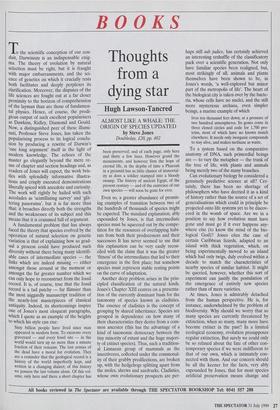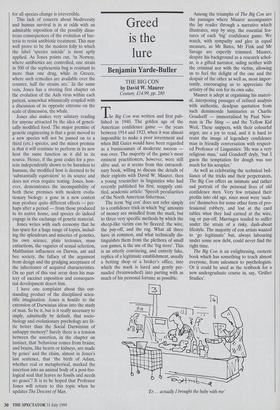BOOKS
Thoughts from a dying star
Hugh Lawson-Tancred
ALMOST LIKE A WHALE: THE ORIGIN OF SPECIES UPDATED by Steve Jones Doubleday, £20, pp. 402 To the scientific conception of our con- duit, Darwinism is an indispensable enig- ma. The theory of evolution by natural selection must be right, but it is fraught with major embarrassments, and the sci- ence of genetics on which it crucially rests both facilitates and deeply perplexes its clarification. Moreover, the disputes of the life sciences are fought out at a far closer proximity to the horizon of comprehension of the layman than are those of fundamen- tal physics. Hence, of course, the prodi- gious output of such excellent popularisers as Dawkins, Ridley, Diamond and Gould. Now, a distinguished peer of these illumi- nati, Professor Steve Jones, has taken the popularising process to its logical conclu- sion by producing a rewrite of Darwin's `one long argument' itself in the light of modern knowledge. The echoes of the master go elegantly beyond the mere re- use of chapter and section headings and, as readers of Jones will expect, the work bris- tles with splendidly informative illustra- tions and crisply executed demonstrations liberally spiced with anecdote and curiosity. The work will rightly be hailed with such accolades as 'scintillating survey' and 'glit- tering panorama', but it is far more than that: it broaches directly both the strengths and the weaknesses of its subject and this means that it is crammed full of argument.
A fundamental problem that has always faced the theory that species evolved by the operation of natural selection on genetic variation is that of explaining how so grad- ual a process could have produced such diversity without there being many identifi- able cases of intermediate species — the links which are indeed missing — either amongst those around at the moment or amongst the far greater number which we can only hope to reconstruct from the fossil record. It is, of course, true that the fossil record is a tad patchy — far flimsier than the most niggardly manuscript tradition of the nearly-lost masterpieces of classical antiquity. Indeed, its shortcomings inspire one of Jones's most eloquent paragraphs, which I quote as an example of the heights to which his style can rise: Sixty billion people have lived since man appeared in modem form. To excavate every graveyard — and every fossil site — in the world would turn up no more than a minute fraction of their remains. The lost armies of the dead have a moral for evolution. They are a reminder that the geological record is a history of the world imperfectly kept, and written in a changing dialect; of this history we possess the last volume alone. Of this vol- ume, only here and there a short chapter has
been preserved; and of each page, only here and there a few lines. However grand the monuments, and however firm the hope of eternal life, in the depths of time a Pharoah in a pyramid has as little chance of immortal- ity as does a soldier stamped into a bloody swamp. The history of ancient Egypt, of the present century — and of the existence of our own species — will soon be gone for ever.
Even so, a greater abundance of promis- ing examples of transition between two of the hundreds of thousands of species might be expected. The standard explanation, ably expounded by Jones, is that intermediate species must be squeezed out by the compe- tition for the resources of overlapping habi- tats from both their predecessors and their successors It has never seemed to me that this explanation can be very easily recon- ciled with the claim that it was the greater `fitness' of the intermediates that led to their emergence in the first place; but somehow species must represent stable resting points on the curve of adaptation.
Another deep problem arises in the prin- cipled classification of the natural kinds. Jones's Chapter XIII centres on a presenta- tion of the currently dominant basis for the taxonomy of species known as cladistics. The essence of cladistics is the concept of grouping by shared inheritance. Species are grouped in dependence on how many of their characteristics they derive from a com- mon ancestor (this has the advantage of a kind of taxonomic democracy between the tiny minority of extant and the huge majori- ty of extinct species). Thus, such a tradition- al Linnaean group of mammals as the insectivores, collected under the commonal- ity of their grubby predilections, are broken up, with the hedgehogs splitting apart from the moles, shrews and aardvarks. Cladistics, whose own evolutionary prospects are per- haps still sub judice, has certainly achieved an interesting reshuffle of the classificatory pack over a scientific generation. Not only have familiar species been realigned, but, most strikingly of all, animals and plants themselves have been shown to be, in Jones's words, 'a well-explored but minor part of the metropolis of life'. The heart of the biological city is taken over by the bacte- ria, whose cells have no nuclei, and the still more mysterious archaea, even simpler beings, a marine example of which lives ten thousand feet down, at a pressure of two hundred atmospheres. Its genes come in three closed circles and code for 1,700 pro- teins, most of which have no known match elsewhere. It needs only inorganic compounds to stay alive, and makes methane as waste.
To a system based on the comparative anatomy of DNA, such primordial beings are — to vary the metaphor — the trunk of the tree of life, with plants and animals being merely two of the many branches.
Can evolutionary biology be considered a genuinely predictive science at all? Cer- tainly, there has been no shortage of philosophers who have decried it as a kind of history rather than the source of a set of generalisations which could in principle be projected onto life systems yet to be discov- ered in the womb of space. Are we in a position to say how evolution must have gone and must go if it ever happens any- where else (to know the mind of the bio- logical God)? Jones cites the case of certain Caribbean lizards, adapted to an island with thick vegetation, which, on being experimentally moved to an island which had only twigs, duly evolved within a decade to match the characteristics of nearby species of similar habitat. It might be queried, however, whether this sort of experiment can justify the postulation of the emergence of entirely new species rather than of mere varieties.
At times, Jones is admirably detached from the human perspective. He is, for instance, underwhelmed by the problem of biodiversity. Why should we worry that so many species are currently threatened by extinction, when so many, many more have become extinct in the past? In a limited ecological economy, evolution presupposes regular extinction. But surely we could only be so relaxed about the fate of other con- temporary species if we were indifferent to that of our own, which is intimately con- nected with them. And our concern should be all the keener for the facts, very ably expounded by Jones, that for most species artificial preservation means change and for all species change is irreversible.
This lack of concern about biodiversity and human survival is in at odds with an admirable exposition of the possibly disas- trous consequences of the evolution of bac- teria to resist antibiotic treatment. This may well prove to be the modem folly to which the label 'species suicide' is most aptly applied. As Jones points out, 'in Norway, where antibiotics are controlled, one strain in 500 of the septicaemia bug is resistant to more than one drug, while in Greece, where such remedies are available over the counter, half the strains are.' In the same vein, Jones has a riveting first chapter on the evolution of the Aids virus within each patient, somewhat whimsically coupled with a discussion of its opposite extreme on the scale of dimension, the whale.
Jones also makes very salutary reading for anyone attracted by the idea of geneti- cally modified food. The major premise of genetic engineering is that a gene moved to a new species will not be passed on to a third (etc.) species, and the minor premise is that it will continue to perform in its new host the same function as it did in its source. Hence, if the gene codes for a pro- tein independently shown to be harmless to humans, the modified host is deemed to be `substantially equivalent' to its source and does not even require testing. Jones, how- ever, demonstrates the incompatibility of both these premises with modern evolu- tionary biology: a gene in a new context may produce quite different effects — per- haps after a period — from those produced in its native home, and species do indeed engage in the exchange of genetic material.
Jones writes with such economy that he has space for a huge range of topics, includ- ing the splendours and miseries of genetics, his own science, plate tectonics, mass extinctions, the vagaries of sexual selection, Malthusian influences on Darwin, ant and bee society, the fallacy of the argument from design and the grudging acceptance of the inheritance of acquired characteristics. On no part of this vast array does his mas- tery of succinct exposition and consequen- tial development desert him.
I have one complaint about this out- standing product of the disciplined scien- tific imagination. Jones is hostile to the extension of Darwinian ideas into the study of man. So be it, but is it really necessary to imply, admittedly by default, that socio- biology and evolutionary psychology are lit- tle better than the Social Darwinism of unhappy memory? Surely there is a tension between the assertion, in the chapter on instinct, that 'behaviour comes from brains; and brains, like hearts or kidneys, are made by genes' and the claim, almost in Jones's last sentence, that 'the birth of Adam, whether real or metaphorical, marked the insertion into an animal body of a post-bio- logical soul that leaves no fossils and needs no genes'? It is to be hoped that Professor Jones will return to this topic when he updates The Descent of Man.



























































 Previous page
Previous page